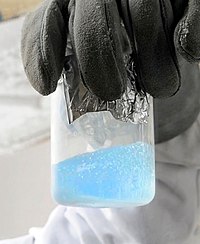
Photo from wikipedia
Abstract Fermentation kinetic and oxygen transfer modelling coupled with energy analysis was applied to investigate how key input design variables influenced fermenter size, feed substrate requirement, wasted substrate and aeration… Click to show full abstract
Abstract Fermentation kinetic and oxygen transfer modelling coupled with energy analysis was applied to investigate how key input design variables influenced fermenter size, feed substrate requirement, wasted substrate and aeration system electrical energy requirement. The study showed that trade-offs and compromises are required to select the values of key input variables that can produce superior process designs in terms of the output variables. For example, reducing steady-state oxygen concentration reduced aeration system energy requirements and associated carbon footprint but increased fermenter size and associated cost. Mathematical modelling can assist in more precisely zoning in quantitatively on the selection of design input variable values that can produce a best compromise between conflicting design output variables. Mathematical modelling can also highlight design sensitivities. For example, if the steady-state sugar concentration is reduced below a certain value, then this can lead to an exponential increase in fermenter volume and associated cost, thus it is prudent to operate on the conservative side of this value.
Journal Title: Food and Bioproducts Processing
Year Published: 2017
Link to full text (if available)
Share on Social Media: Sign Up to like & get
recommendations!